My father David Ralph had left the ranch for Denver seeking opportunity when he met Helen Sayre, nee McDaniel, divorced with two daughters - Dorothy and Jeanne. She was running a small Denver boarding house trying to make ends meet with her two daughters when Ralph stayed there.
My Life Begins
Helen and Ralph married Dec 25, 1924, and I was the first born of that union, May 18th, 1928, as I said, on a kitchen table in Englewood, Colorado. I was born just one year before the Great Crash of 1929, and the following Great Depression.
 |
|
One of the earliest pictures of me |
Times got tough for my father and mother. We lived in Pueblo. I have City records showing we lived in no less than 6 rental homes. In one place on the fringes of town I remember we had a milk cow tethered in the back yard and my mother sold eggs and milk.
My father became a General Foods salesman. And reflecting his Welsh heritage, he could sing, while I, his son, never really could. One memorable day while I was perhaps 6, I remember he took me down the Front Range of Colorado - in our early Ford - to make sales of General Foods products. When he got to Walsenburg, he put me up on the counter, and had me sing “Home on the Range” to help him close a sale.
|
Model T at the ranch, similar to the car my father owned |
 |
| Me, as photographed by a Travelling Vendor |
Young as I was my father did what he could even though we lived then in the city, to remind all what cowboy stock I was from.
My sister Bette Lee was born in 1934 in Pueblo. Which made her six years younger than I.
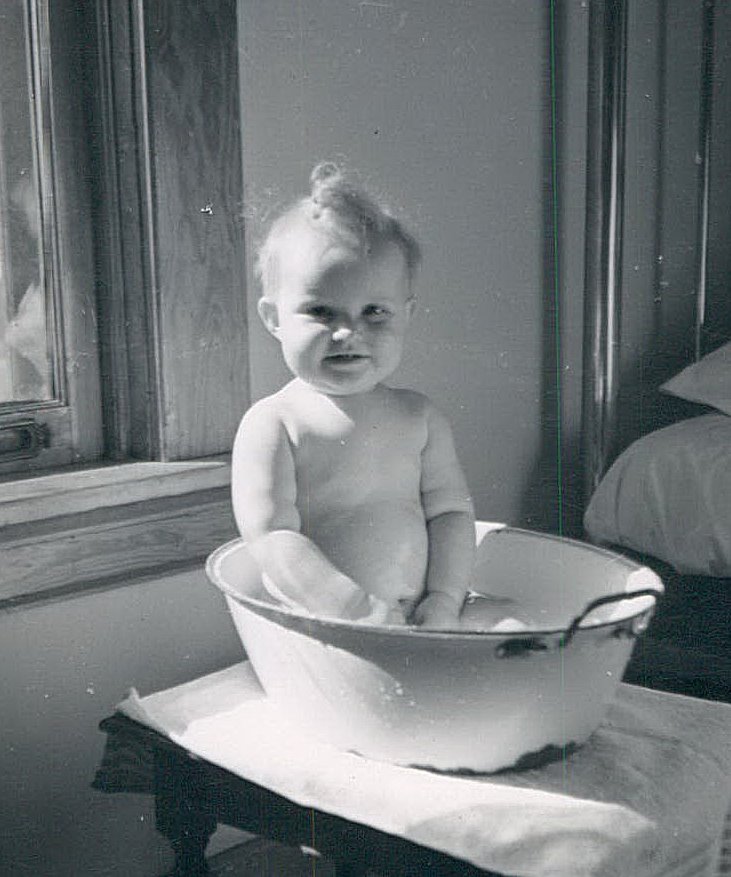 |
| Bette Lee Hughes |
(I do have a later picture of Bette visiting the ranch too which I will post here. But I have to find it - it is not in the Leila Scrap Book)
When Bette arrived we lived in a Spanish style house right across the street from the famed ‘Bessemer Ditch’ of Pueblo County. That was a vital irrigation ditch that was created in 1897 which ran through many residential areas of Pueblo. It was at least 10 feet wide and several feet deep past where we lived at 630 Van Buren Street.
Van Buren had a bridge across the ditch which led, two blocks away to a small public park with swings and gym bars which kids, including me, liked to play on.
The only problem was that we owned a German Shepard, called Gretchen. If anyone was more concerned than my mother about the dangers of me falling into the Ditch, it was Gretchen. She simply would not let me cross that bridge to reach the playground. But she also had an Achilles Heel. She, in turn, was frightened of lightning and thunder.
So one day, it stormed, and my mother had to lock Gretchen in the basement. When the weather cleared, my mother asked me to walk to the grocery store – also over the bridge – and buy some bread. I did that, but when I returned and put the bread on the counter in the kitchen with the change, I dashed out the door, raced over the bridge, and free at last, ran to the playground and played a long time with other kids.
Meanwhile my mother, having had to tend to baby Bette somewhere in the house, didn’t hear me leave. But when she saw the bread and change, and no me anywhere within shouting distance outside, she panicked.
When I walked back from the playground, I saw a commotion on the far side of the Bessemer Ditch. My mother was there, uniformed men, and they were throwing something into the water. They were grappling for my body!
Then Gretchen, the dog, spotted me, raced over the bridge and pulled me by my britches all the way back across the bridge!
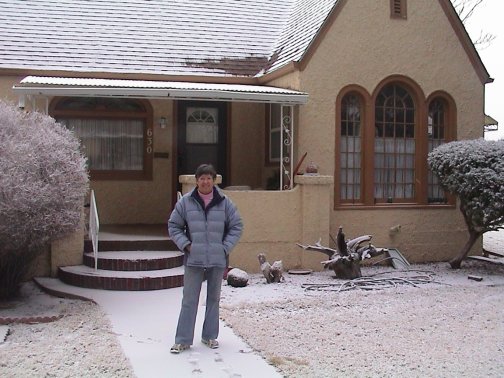 |
 |
| 630 Van Buren Street. Bette Hughes who was born there in 1934. Pictured in the 1990s. | The Bessemer Ditch by our House |
The Five Other Places we lived in Pueblo, between 1930 and 1935. (All six of these pictures were taken Feb 8th, 2007)
 |
 |
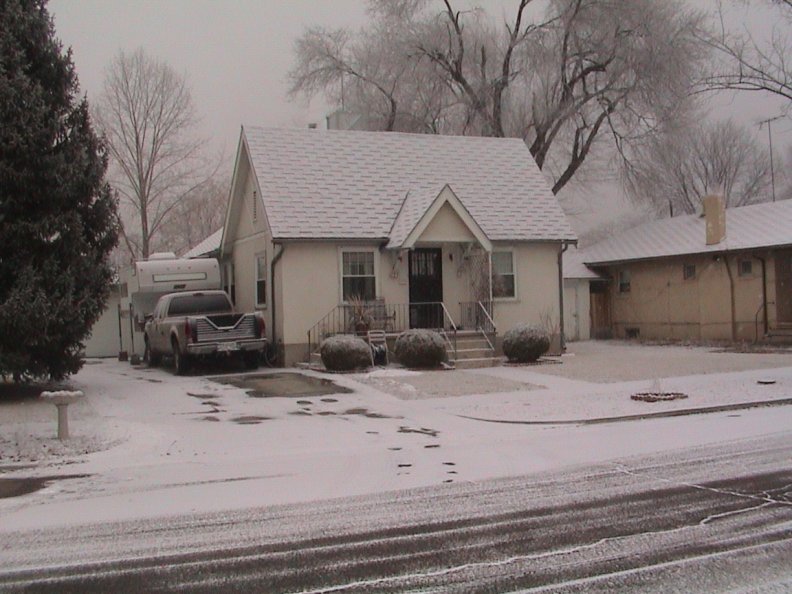 |
| !003 Carteret Street | 305 Berkely Avenue | 632 Euclid |
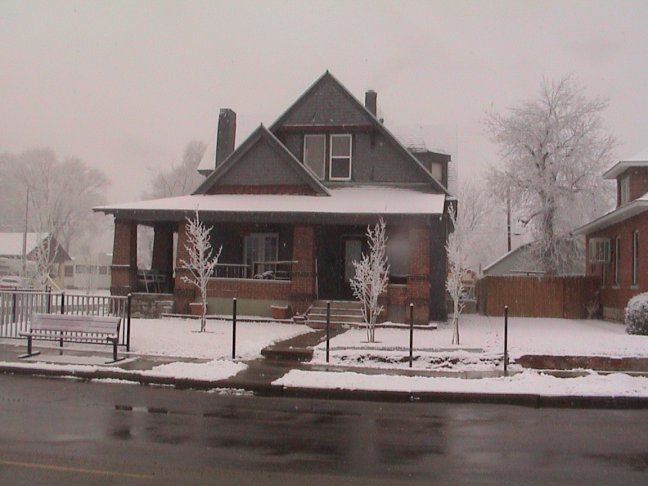 |
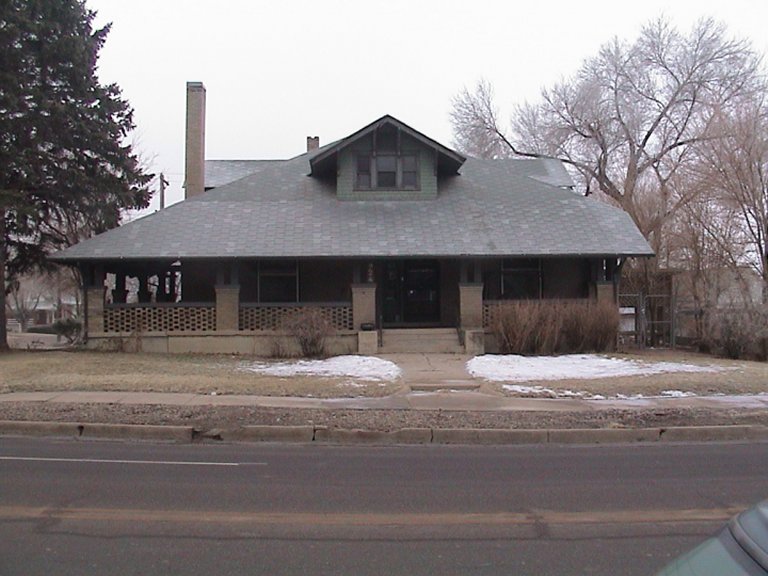 |
| 305 E Orman | 924 E 8th Street |
My mother, Helen, was always able to wheel and deal places for us to live while we were struggling to make a living in Pueblo. That served her well after my father died and she had to move us to Denver, and she was able to lease a series of larger homes to rent out rooms and run them as Boarding Houses.
My memory of my father was very spotty. For he was gone a lot, trying to make a living. Hard up as we were, he tried to be generous with down on their luck others. One day a man who was peddling his art came to the door. Besides giving him a meal my father bought one of the man's collage, three dimensional paintings.Those were the times when men, and women, would try to peddle whatever they had to offer door to door.
 |
| One of the original Depression Era Paintings my father purchased from a house-to-house painter |
Another incident happened while we lived in Pueblo. On day my mother took me to the premises of a local radio station, where they must have offered the public the opportunity for kids with some talent to exhibit it over the radio. I am sure in that era of 'Shirley Temple' and other cute children in early movies, my dad probably prompted my mother to take blonde, curley haired me, to sing - probably again 'Home on the Range'. I am sure my mother thought there was a chance that somebody might pay for my child-actor talent. Fat chance. For I knew I could not sing very well. Maybe write.
But then the other half of the story stuck with me. When we got home, I remembered going over to our big brown - with an arched top - radio. For the first time as I stared at it, I tried to vizualize what it took for the radio station to take my voice, project it over the air to radios like that which large numbers of people in their homes could hear. The technical 'concept' of radio got through to me at about 5 years old.
One of my other early memories of my father was of riding out to the ranch with him in our early Model Ford. We were arriving long after dark in a rainstorm, and had to cross the fast moving, very wide, if shallow, Comanche Creek. For some reason he had chosen to drive north out of Kiowa about 10 miles, then east on the county road that would lead to our mailbox, instead of driving east four miles out of Kiowa, across the Comanche Creek bridge, then 10 miles north to our mailbox parallel to Comanche Creek - the most regular route. Maybe he learned something in Kiowa about flooding Comanche Creek reaching the dirt road next to it all 10 miles north. I can still remember – I was perhaps 5 years old at the time - standing on the passenger seat looking through windshield at the weak yellow headlight light reflecting off fast running turbulent water rushing past our front, and splashing against our left door. Intermittent Comanche Creek was at least an eighth of a mile wide there. Wide, fast, shallow water after a cloudburst was dangerous, and I sensed it. It was frightening. I didn’t know until years later what the term ‘flash flood’ meant but we were in one. But the sporty Ford with its four narrow wheels were on a hard, if wide, sandy bottom which my ranch-raised father obviously knew existed beneath, and he trusted. So we made it safely across the Comanche in the dead of night to the Ranch house.
I spent many entire summers, both before and after my father died on that ranch. I first learned to shoot there – at coyotes in their orchard. And at rattle snakes. And how to milk the cows, collect the eggs, feed cattle in the barn, and observe a cow delivering a calf midst the cactus and Soapweed – called Spanish Bayonet by others. And ride at a very early age with the ranch hands rounding up the cattle over the other, east side of the high ridge that divided the ranch between the Comanche and West Bijou creeks which flanked our ranch.
Then I would sit with the ranch hands on summer evenings after supper, with their backs leaning on the ranch house wall, talking and picking their teeth with weed stalks, while the sun was setting. My big ears took in all the down home western wisdom cowboys were willing to part with.
To Aunt Leila who stayed on the ranch I owe learning how to drive a car. When I was about 11 or 12 she trusted me to drive alone from the ranch house 1 mile down the dirt track to the county road where our gate, cattle guard, and Rural Delivery Mail Box stood. Get the mail and drive back in a stick shift early Ford. All I had to do was keep the wheels in the road ruts the whole way, shift gears, use the gas and break pedals. I couldn’t get into much trouble, for if I oversteered, the wheels just went off into the cactus. It was from her I learned from that manual gear shifts on cars of that day formed the letter 'H.' And one shifted from the near side bottom of the H as low, to the right top as 2d, then to the right bottom as high gear. I never forgot it during the stick shift era of Detroit.
As I realized later kids my age only knew how to operated automatic drives. not a stick-shift car.
By then we lived on east 8th Street, Pueblo,on the far east side of town in an old dark brick, deceased doctor’s, house. Street car tracks passed in front of our house. Fountain Creek, coming down from the north beyond Colorado Springs and beyond crossed under 8th street 4 blocks west of our home.
In the early spring of 1935 Southern Colorado got a huge rainstorm. A legendary flood started west above Colorado Springs causing destruction all the way south down Fountain Creek through Pueblo to the Arkansas River. I remember the night after the immediate rain stopped, walking up the street to the blocked-off 8th Street bridge over Fountain, and seeing, with amazement complete frame houses floating down the river going under the bridge. My first exposure to the damage ‘flash floods’ could do in populated areas. I was learning what the extreme climates of Colorado could bring about.
Then the second family disaster struck.
Death of My Dad, D. Ralph Hughes
One morning when I awoke, I looked inside the garage to stare at our car which had carried my father, another man driving him back home from a business trip for he got very sick on the road. Next thing I knew I was sitting in a car at night outside the Pueblo Hospital with my sister Bette, while my mother stayed inside for a long time. He had had a ruptured appendix, but having been brought up in the Christian Science faith, declined medical help until it was too late. He died March 8th, 1935. He was 37 years old.
I was 7 and my sister Bette was 1. That was a calamity for my mother, for we had little insurance and it was the Great Depression.
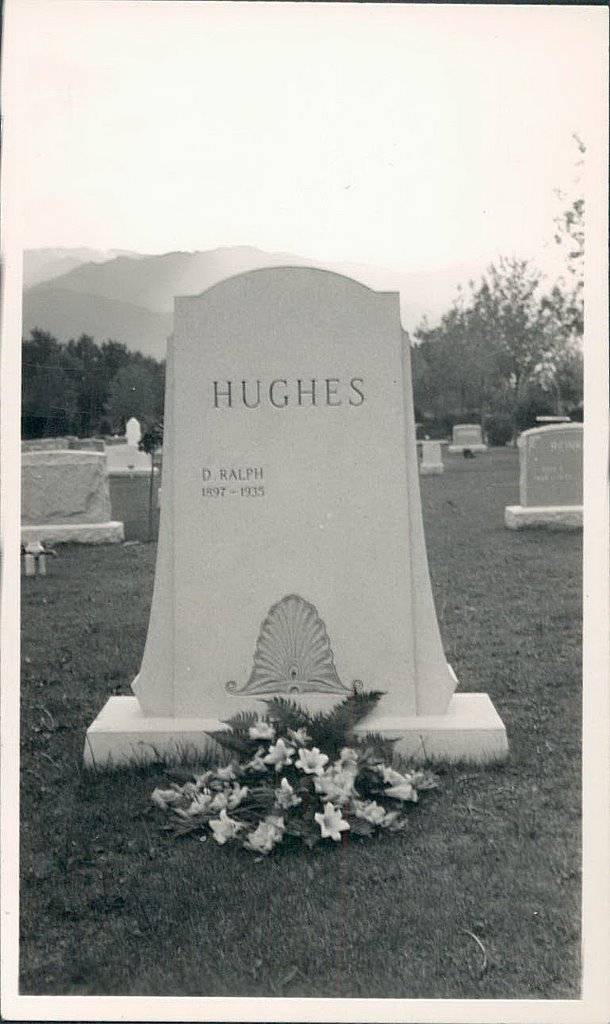 |
|
Evergreen Cemetery Colorado Springs |
So I grew up from the age of 7 without a father.
Meanwhile Edward and Arleen had begun to make it in the stocks, bonds, and investments business. He, with wife Arleen as a partner was rising on the economic bubble of the mid and late 1920’s. They had one saving virtue. They made, with their own funds, conservative investments in basic industries – in North Field water that served Colorado Springs, in Utilities stocks, later Utah Ice and Storage which were not big boom-bust speculative stocks.
They established the office of E.W. Hughes and Company on the 5th floor of the Exchange National Bank building in Colorado Springs. Arleen essentially ran that office, while Ed opened an office at 1 Wall Street, New York City, close to the New York Stock Exchange, and to and from which Edward flew on one of the earliest air carriers - United Airlines. Before he died he had a plaque from the airline showing that he had flown the equivalent of 4 times around the earth – just between Colorado and New York - in the mid 30's.
His wife Arleen never put her foot on an airplane step all her life.
'Uncle Ed' got me my first Plane ride. A big Trimoter Plane which offered short flights to residents landed at the Alexander Aircraft Company field on the north side of Colorado Springs.
After my father died in Pueblo in 1935, and before Ed died in 1939, the three brothers had an understanding that they would help out each other if they got in trouble. My mother, Helen was desperate during the Depression to find a way to support we four children. So she moved to Denver with the three girls, living at first in affordable apartments, and then trying her hand at running a series of reasonably successful boarding houses in south Denver. She could not make a home for me there yet. That was a problem.
So Ed and Arleen took me into their Wood Avenue home, from where I walked to and from Steele Elementary School and got the first clue that I had some talent for writing – a legacy of my Celtic Welsh heritage – when I was promptly promoted a grade level for my excellence in ‘reading and writing.’
It was about that time, when I was living at Arleen and Ed's mansion that my beyond-school interest in writing and reading emerged. I started reading voraciously, and idly began to write little stories on yellow pads, longhand.
The Wood Avenue mansion had two libraries - one in the formal dark 'living room' with its overstuffed chairs, grand piano, and another in the informal, better lighted, large den where a tall reed organ also stood.
The bookshelves in the living room had classics like Thackery novels, the complete Shakespeare plays, and 12 volumes of big red 'Smithsonian Scientific Series' books. The Smithsonian even had a section that had been imprinted with flousescent ink displaying an under-ocean scene that could be made to glow in the dark as it described the technology and chemistry.
In the den were individual books, including more popular western ones like "Stampede to Timberline."
Those two libraries were the 'expected' acroutements in modern mansions. I never saw either Ed or Arleen read any of them.
I began to devour all of them.
About that time Uncle Ed brought me a complete booklet with lessons in French in it. Together with occassional comments I overheard, I think Ed and Arleen were considering sailing to Europe, and taking me with them,
About that time, my Grandmother Ellen Hughes, having left the ranch in the hands of Leila and Ray Snyder, also lived at Arleen Hughes home on Wood Avenue. She had become what is called a ‘Christian Science Practitioner’ – someone who through prayer helps people in need. She earned an income from that all her remaining life. Sometime between the 1940a and 50s, she got to travel to Boston to see the 'Mother Church' and stay there for a few days with other Christian Science friends from Colorado Springs, where its Christian Science Church still stands on Cascade, Avenue.
I attended Sunday School there for the year I lived on Wood Avenue.
I was impressed by the gentle teachings about Christianity that was I exposed to. No hell fire and damnation. Christian Science was a gentle, intellectual, religion. For some reason I strongly remember one male Sunday School teacher who had to catch his breathe when talking. For I was told he had been gassed in World War I. But, as a Christian Scientist, he sought no medical treatment for his affliction.
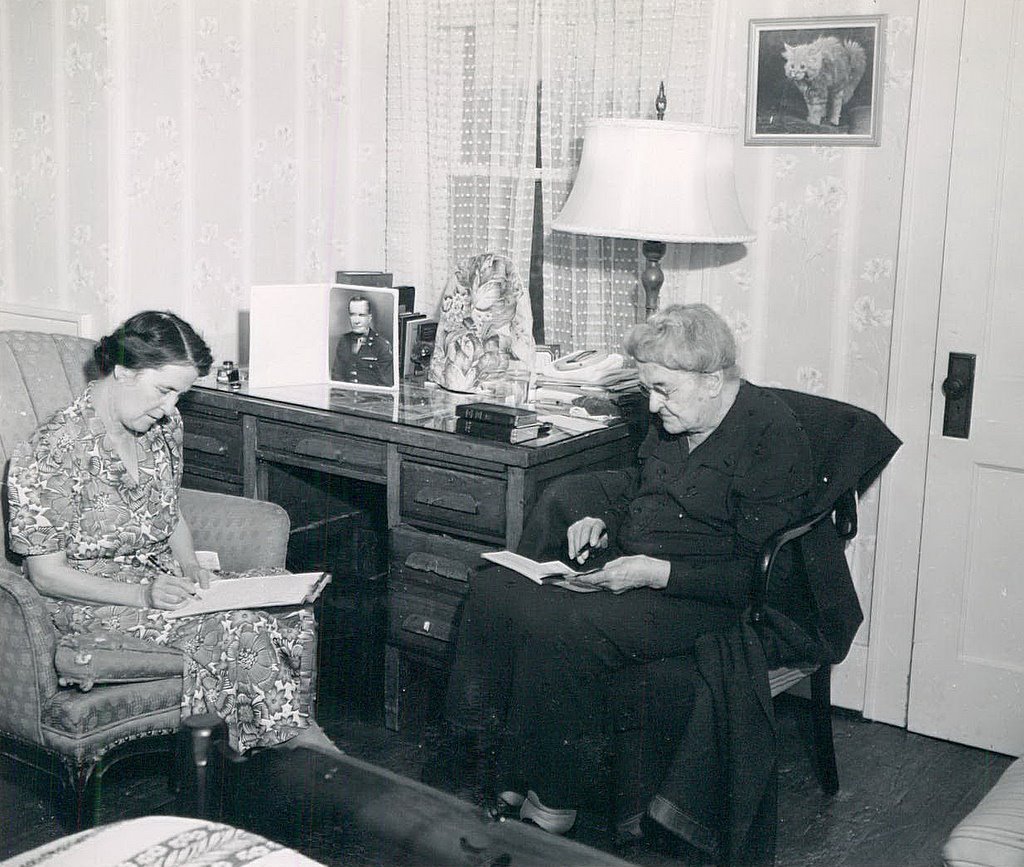 |
| Ellen ( 'Mama' ) Hughes, in her late 80s with daughter Leila. |
Notice the photograph of her son Walter when he was in uniform in WWII. And next to her is her Bible, and Science and Health by Mary Baker Eddy.
She was getting elderly by this time from life on the ranch. So she largely remained in her room reading by a window in her set of rooms. She was a profound influence on me at the age of 8. She was very gentle and soft spoken, gave me a Bible, and we had many long talks in her room as she quietly instructed me in life. While she introduced me to Christian Science and its emphasis of the value of belief and prayer rather than doctor and pills for ailments, my practical nature recognized limits to total reliance on prayer. Yet, all my long life I have managed to avoid pills, doctors, and the current total reliance on ‘medicine’ and 'pills' to cure everything. I am not and never was a pill popper even though I have lived a very active life in the US Military and its wars, and made expeditions to remote places. But I maintained surprisingly good health into my late 880s.
And I noticed later in life the rise in recognition that the health of ‘the mind’ could have a large influence on the health of the body. Not calling it ‘religion’ but some forms of ‘therapy’ to the same end. Beyond the reach of pills.
My reluctance to ‘go to the doctor’ often irritated my children and sometimes bothered my wife. But as the twig is bent…
Uncle Ed took me up on my first Airplane ride on a Ford Tri-Motor passenger plane which flew into the Alexander Aircraft Company field off north Nevada Avenue, and offered a series of short flights for the public. This was in the early days of Flying. Uncle Ed was always progressive.
Republicans to the Core
Ed and Arleen were the Republican beautiful people of Colorado Springs. Attractive and successful, making their way in the heady capitalist world of finance. The five children of Eben and Ellen Hughes never drank nor smoked, even during that Flapper 20's Era of booklegged liquor. And that non-smoking habit was passed down to all their children, including me. And in my later life I was pleased to know my three children never smoked either - perhaps from my model as their father - and took liquor only in moderation.
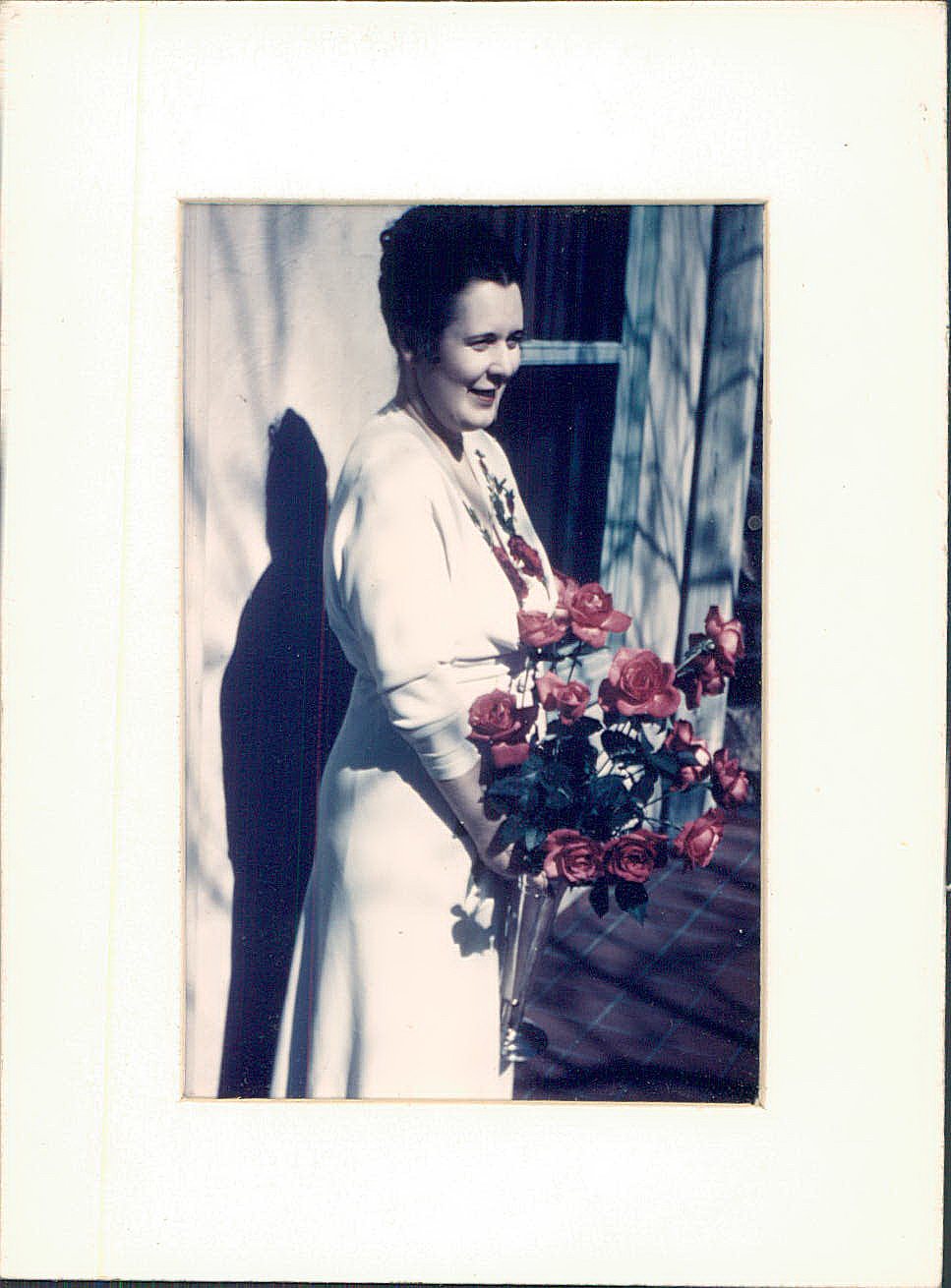 |
|
Arleen Hughes in her salad days. |
 |
|
Handsome, well tailored Ed Hughes, in front of their Wood Avenue mansion. |
Then the Great Depression came.
But they were not wiped out. Their conservative prudence, investing in enduring needs, Water system paid off - Water Systems, Ice and Storage businesses, Sugar agriculture.
In fact they were successful enough that, just as the crash of 1929 was looming, they were able to buy a mansion on Colorado Springs at 1225 Wood Avenue - on Millionaire’s Row which was created out of Cripple Creek Gold 20 years earlier. They bought it for only $20,000 from mining interests which were in trouble. The last time I checked - in 2000 - it was listed for sale at $2.5 million.
Because of the proximity of their home to the Colorado College campus, where Edward had graduated, and Arleen attended, they became benefactors of the college. To include the donation of a Sorority House to the College. And perhaps more significantly they invested savings of some of the staff and professors.
60 years later after a retired Colorado College Chemistry Professor – Otis Barnes – died in the 1980s he left the largest bequest ever made to Colorado College. When his well-provided-for widow Margaret was asked by the press how a mere college professor could have made such a bequest, she answered that Ed and Arleen Hughes had invested their funds wisely.
Besides investing their own funds, the Hughes's sucessfully invested the savings of many other persons in Colorado Springs.
Ironically, Arleen, who never completed college, though she attended three said that she didn’t think women needed to be a graduate. She had made it, so could they.
Ed and Arleen’s Wood Avenue home was the mecca to which all the relatives showed up, especially in summers, and including at Christmastime when a giant decorated Christmas tree – 12 to 15 feet high inside – graced a Den during the season. It stood next to a tall antique pump reed organ that I grew up playing around on.
Death of Ed Hughes
The third tragedy in the family occurred in the late 30s - the first having then been Eben’s death in 1921 followed by my father Ralph’s death in 1935. Edward Hughes in October 1939 developed food poisoning. On account of his adherence to Christian Science, he also did not go to a hospital. And after weeks of declining health - at home - he died in 1939. 46 years old.
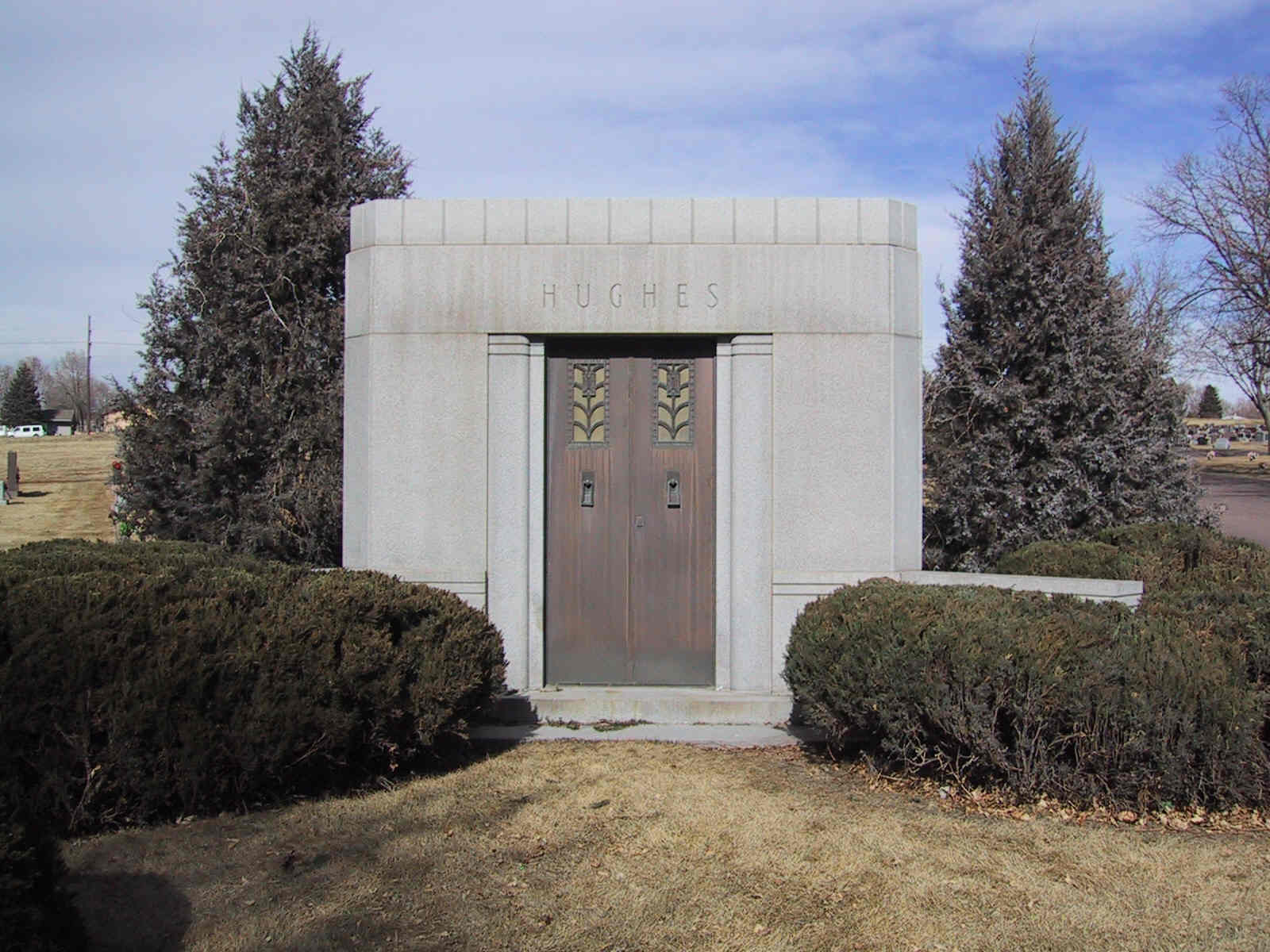 |
|
The Ed and Arleen Mausoleum - Evergreen Cemetery |
.
But the Hughes family had stayed reasonably close through all those earlier years. I have many photographs of all the siblings meeting on the ranch and in and around Colorado Springs. That is about when the next generation – including me and my younger sister Bette – started showing up at the ranch or at Arleen’s mansion in the summers. For those like Mary, the youngest, who married John Kretchmer developed a growing Photography business in Omaha, Nebraska the Ranch was a summer vacation spot, and ‘Aunt Arleen’s House’ with its 7 bedrooms , drawing room, large dining room, huge pane glassed in breakfast room, den room, sun room, was visited repeatedly by both Hughes and Wilsons from her Pennsylania side of the family.
Arleen Hughes never remarried. She took over the E.W. Hughes Investment Company affairs without a break. In fact those of us who thought for years she might just retire after Edward died and clip bond coupons for her income, she actively managed the company and expanded its holdings.
She regulated her life - and expected all others in her home, to regulate theirs on her invariable schedule. Breakfast was at 7AM sharp. When I lived there - in my own room on the top floor of the mansion, and was required to take a tub bath every single day, I would listen to the chimes on the large grandfather clock that stood on the second landing of the wide stairs and could make it to the breakfast room before the 7th chime. Don't be late was the rule.
And at exactly 8:45 I would watch for a fascinating and unvariable routine. A maid, carrying a small china dish with one cube of ice in it, would carry it up to 'Aunt Arleen's room. And then go back downstairs as soon as she had delivered the ice cube in Arleen's closed-door room. Later I figured it was for her morning ablutions - rubbing it on her soft white face.
Then she was driven to the Exchange National Bank building down Cascade Avenue by her chauffeur-gardener, Harry, in her latest model Cadillac, every morning at precisely 9AM,. She returned by noon to then manage through her gardener, cook, and maids her elegant mansion, grounds, and roses – which became an obligatory stop on various Colorado Springs Ladies society's and gardening outings. She had fine taste. From fine furs to Miocene China sculptures.
She made, by Pullman train car only, yearly trips to the Biltmore Hotel in New York City after Ed's death to attend meetings of the Boards of Directors of various corporations, where she was an investor and officer. Later, when she owned stock in a sugar business, she was driven – never over 50 miles per hour – to Phoenix, Arizona, where other of her investments were. I long suspected she may have had the smarter business brains than husband Edward.
One indication of her Republican credentials and an obvious willingness to contribute to political candidates whom she regarded as sufficiently 'conservative' came in on one of those trips to Phoenix. She stayed in a first class hotel, and supped in its dining room. One day in the 1960's she was dining alone, when Senator Barry Goldwater came to her table to introduce to her a litle known potential Presidential Candidate. His name was Richard Nixon.
Such was the importance of Colorado Springs wealthy Republican-cause doners.
Even though Arleen Wilson Hughes died 30 years after Ed, and she chose to run the E.W. Hughes investment company until her own death, she left trust funds with quarterly stipends for nephews and nieces from capital amounting to over one million dollars. J. P. Morgan still manages that trust 45 years after she died.
Arleen and Ed, then Arleen alone were quintessentially American rock-ribbed Republican Capitalists. I was reading in her den books by Republican Presidential Candidate Wendell Willkie when I was 11. The Libertarian publisher of the highly conservative Colorado Springs Gazette newspaper lived across the street. And at one gathering at her home when I was no more than 9, the elderly son of the founder of Otis Elevator Company, pressed into my small hands a finely bound copy of the Declaration of Independence and the Constitution. Rock ribbed conservatism in the Hughes family.
Though neither Ed nor Arleen had any children they expressed their affection for their very many nephews and neices with their generosity towards them. They were not particularly demonstrative with the children who stayed there. In fact when I lived for a year in that mansion I regarded Aunt Arleen as somewhat cold. I was not very happy there or then in that large cold mansion. I felt lonely. Part of that feeling, I think, came from her never having any children of her own. The other part was the reserved, very self controlled, conservative and traditional life style she lived. She insisted on the boys and girls behaving themselves in her house, from the dinner table to the recreation room.
If she had any weakness, it was that she was a clothes horse, with scores of shoes, and hats.
When I met the few other children that were in the neighborhood with its many large, cold mansions owned by the very wealthy on Millionaires Row, I got a glimpse of how the wealthy of the world lived.
 |
|
Ewing (Walter's son) Kieth, Joan (Mary's children), Bette and I (Ralph's son and daughter) at the Circus in Colorado Springs in the 1940s.
|
 |
|
Me with Aunt Arleen at the 7 Falls in Colorado Springs |
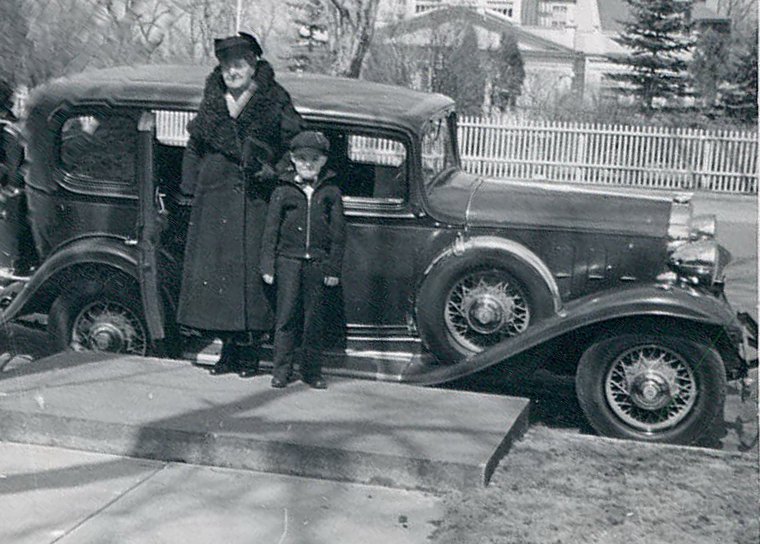 |
|
The fine Cadillac 1935 car owned by Ed and Arleen in which, Grandma Hughes and I at 7 years old got to be driven around. |
There is a great story about that granite slab at the curb. For it was designed to be the step-down from a Horse Carriage before autos were available. But the new fangled automobile's doors often banged into that high slab. So Uncle Ed put four sawed off logs on the brick patio to the rear of the house, and put that heavy slab on them as a Picnic Table! Know what? IT IS STILL THERE! (2011) And not 1 in 10,000 people would know where that picnic table came from, including the current house owners. I am that one person who knows.
After having gone to Steele Elementary School in Colorado Springs, I was able to join my mother and sister Bette in Denver, where my serious education started.
My mother always wanted to dress me up, and have a photograph professionally made to mark my progress over the years.
Here is one of the earlier ones, taken when I was 12 years old.

